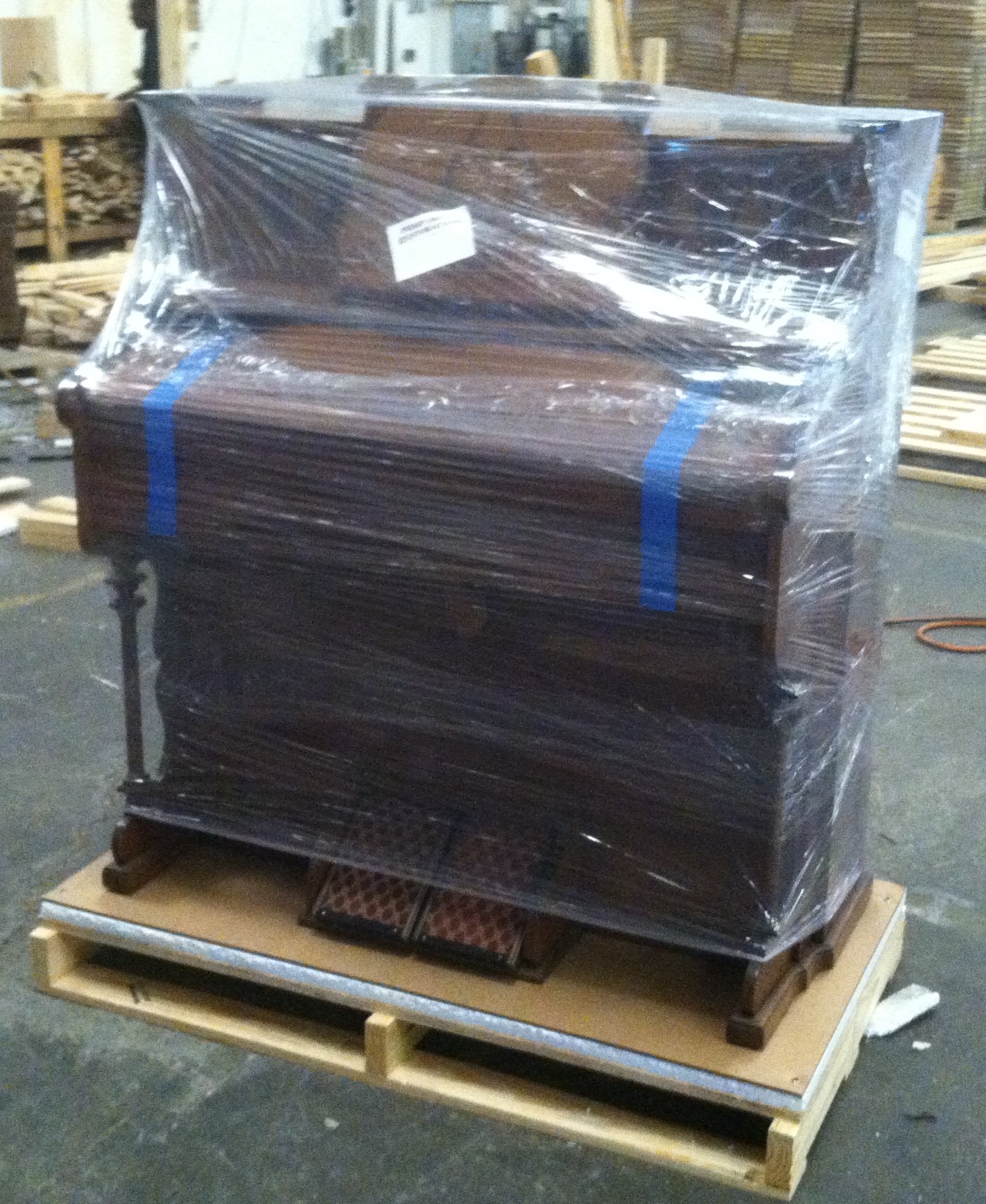When Buffalo, NY was the
Melodeon Capital of the World
Written: Chase Viele
This Story first appeared in the winter 1997 Heritage Magazine
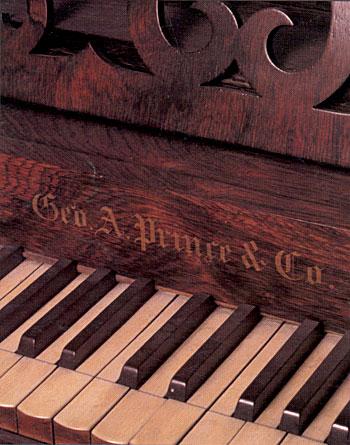 During the second half of the 19th century, Buffalo, New York could claim it was "The Melodeon Capital of the World." Today, few
people could describe a melodeon. During the second half of the 19th century, Buffalo, New York could claim it was "The Melodeon Capital of the World." Today, few
people could describe a melodeon.
A melodeon is a small reed organ with a five- or six-octave keyboard, most often housed in a piano-like case. It was so popular in the United
States and throughout the world 100 years ago that its sales surpassed those of the piano, which was more complex and costly to produce.
The melodeon produces its tones by drawing air in through suction. The air passes over metal reeds, activated by foot pedal bellows. The
instrument's predecessor, the European harmonium, was played by expelling air from within by compressing the bellows. By using suction on free
reeds, the melodeon inhibits the propagation of overtones by drawing wind pulses into itself, rather than propelling them outward toward the
listener.
The "improved melodeon," which eventually brought tonal, harmonious musical pleasure to millions, was invented in Buffalo. Two Yankee
artisans, Jeremiah Carhart of Poughkeepsie and Elias Parkman Needham of Delhi, joined the swelling populace of Buffalo around 1835. They
immediately found work in cabinet making and carpentry shops in the Washington, Swan and Seneca street area.
Common interests drew the two young men together. They soon combined their inventive energies and their skills with the lathe, saw and
mechanical tools to develop the improved melodeon, or American organ. Of great significance tonally was the switch from force or pressure bellows
(as in the harmonium) to the improved melodeon's suction bellows. This achieved something close to the sound of the pipe organ, reaching a major
musical milestone.
The patent of this suction principle was secured by Jeremiah Carhart on Dec. 28, 1846 (U.S. Patent Office No. 4912). After years of experiment
and tinkering, this innovative and historic invention finally materialized while Carhart and Needham were in the employ of George A. Prince,
owner and proprietor of the George A. Prince & Co. Music Store at 200 Main St.
Earlier 19th century reed organs had a raspy, snarling quality and excessive dissonant overtones. The very first improved melodeon was made in
the upper floor over Prince's music store. Brisk sales immediately followed its introduction.
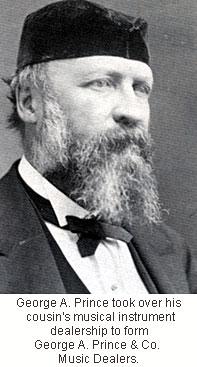 The Buffalo City Directory for 1847-48 lists George A. Prince & Co., Music Store, and also "Geo. A. Prince & Co.,
Manufacturers of Carhart's Improved Melodeons," both at the same Main Street address. Carhart, holder of the patent, had sold manufacturing
rights to Prince while in his employ. Carhart and Needham, maintaining their own manufacturing rights, briefly operated a melodeon making
shop at 269 Main St, then departed for New York City where, in 1849, they established a melodeon "manufactory" at 77 East 13th St,
Manhattan. The Buffalo City Directory for 1847-48 lists George A. Prince & Co., Music Store, and also "Geo. A. Prince & Co.,
Manufacturers of Carhart's Improved Melodeons," both at the same Main Street address. Carhart, holder of the patent, had sold manufacturing
rights to Prince while in his employ. Carhart and Needham, maintaining their own manufacturing rights, briefly operated a melodeon making
shop at 269 Main St, then departed for New York City where, in 1849, they established a melodeon "manufactory" at 77 East 13th St,
Manhattan.
They continued as a New York-based melodeon and reed organ manufacturer until 1868, under the trade name Carhart & Needham. Meanwhile,
manufacturing activity hummed from 1846 onward in Buffalo as Prince and his associates, with bold enterprise, added machinery and skilled hands
to meet the demand for the ever more popular, moderately priced improved melodeon.
West to Buffalo
George Prince, born near Boston, Mass. on Feb. 17, 1818, had entered his cousins' Boston music firm as a youth. When one of those cousins,
John R. Nickels, moved west to Buffalo around 1836 to open a branch of the family business, Prince joined him. He worked as a clerk in the store
at 7 Ellicott Block (235 Main St.). Soon, Prince's entire family moved to Buffalo. By 1837, Prince, his father, mother, sisters and brother, as
well as cousin John were all settled in a small frame house at 117 South Division St, just east of Michigan Avenue. His father, Capt. George I.
Prince, entered the local lakes marine industry.
The family store, known as Nickels & Badger Co. and described as "dealers in musical instruments and umbrellas," relocated to 200 Main St.
in 1839, selling Erie Canal-transported musical instruments and other music items. By 1842, Nickels had sold out to his 24-year-old cousin and
the firm becomes George A. Prince & Co. Music Dealers.
In an interview published in the Buffalo Commercial-Advertiser on Oct. 11, 1886, half a century after his arrival, Prince recalled that the
trip from Boston took him by rail to Providence, by sea to New York and riverboat to Albany, by rail to Utica, in 1836 the western limit of train
service, then finally to Buffalo by stagecoach. Prince also recalled, "I had previously worked in the melodeon factory of a man named Abraham
Prescott at Concord, New Hampshire" (some 100 miles from Boston). There he had obtained from the crude ideas of his employer "the knowledge that
later enabled me, in collaboration with Jeremiah Carhart, to construct the first satisfactory (improved) instrument of its kind."
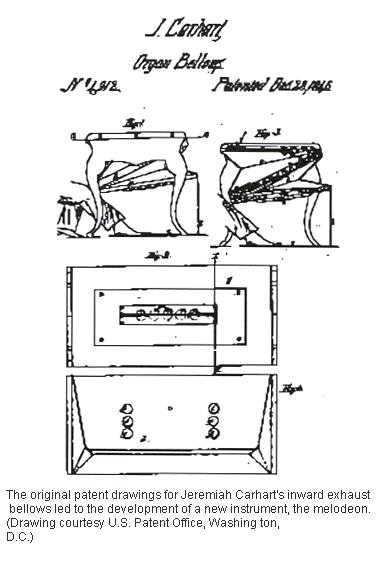 The Carhart-Prince collaboration is now American musical history. Prince's ambitious change from shopkeeper to proprietor of a
production manufactory foretold of an approaching new era in Buffalo's growth and commercial development. Depressed economic conditions had
followed the "land bust" of the late 1830s. Banks and mercantile firms failed due to inflated credit based on speculative land investments
and unstable currency. (Buffalo's first mayor, Dr. Ebenezer Johnson, was among scores of local investors who suffered bankruptcy.) The Carhart-Prince collaboration is now American musical history. Prince's ambitious change from shopkeeper to proprietor of a
production manufactory foretold of an approaching new era in Buffalo's growth and commercial development. Depressed economic conditions had
followed the "land bust" of the late 1830s. Banks and mercantile firms failed due to inflated credit based on speculative land investments
and unstable currency. (Buffalo's first mayor, Dr. Ebenezer Johnson, was among scores of local investors who suffered bankruptcy.)
But by the mid-1840s Buffalo had regained a foothold on prosperity. Its economy turned from the mania for land speculation and mere forwarding
and handling of canal--transported Eastern goods to the more enduring and solid growth factors of grain transportation and transfer, flour
milling, an emergence as a railroad center as well as a port, and a new status as a producer of durable manufactured goods.
The city's growth and commercial sagacity were fostered by elite of well-to-do Yankee merchants, financiers and professional men whose
fortunes were quickly founded, and the community prospered apace. As Buffalo emerged from the village status of the 1830s to the urban maturity
of the 1850s with homes of brick and stone, gaslight streets, curbs and sewers, the Yankees controlled the financial, commercial and social life
of the city, and they continued to do so until well after the turn of the century.
Against this backdrop, Prince, in 1850, purchased from developer Ebenezer Walden the property at 135 Pearl St, immediately to the rear of his
Main Street music store, giving him all of Holland Land Co. rectangular Inner Lot No. 37. At the Pearl Street end of the lot a three-story brick
factory was erected. This allowed a rapid expansion of the firm as the original simply constructed, single keybank, four and five octave (scale
from f to f), double-reed melodeon was supplemented by a variety of more elaborate models and sizes to suit public taste.
Constant experimentation with reeds, bellows, swells and stops led to improved, often patented techniques in Prince's shops. His
superintendent of tuning, Emmons Hamlin, developed in 1848-49 a voicing method that, by twisting the metal reeds, refined the tone markedly.
Hamlin later became a founder of the firm of Mason & Hamlin, a large manufacturer of cabinet reed organs and pianos.
Among Prince & Co.’s reed organ inventions were the divided swell (patented May 22, 1855) and the graduated swell (patented Sept. 17,
1861). The divided swell permits solo passages to be played with the full power of the instrument while the accompaniment is soft and subdued.
With the graduated swell, the tone and volume of the instrument may be eased from a mere whisper to full power and vice-versa, rather than the
complete and abrupt change previously experienced the instant the swell pedal was touched. These inventions and many others led Prince & Co.
to state in its 1876 catalog that "No manufactory in the country has had equal success with ours, in inventing and securing the control of so
many valuable improvements to the Melodeon and Organ."
America Brings the Melodeon Home
At a Washington patent hearing in 1860, Hamlin and Needham estimated that prior to 1846 fewer than 300 reed organs had been built in the
United States. All were handmade to order in small cabinet shops by craftsmen who also built a variety of other instruments.
By the 1850s, reed organs, especially the melodeon, had become a major source of musical entertainment in American homes. As the improved
melodeon caught on nationally, the climate for an industry emerged. Newly developing mid-century factory production methods, a widening network
of rail transportation to urban markets, relatively low prices, a manageable physical size, plus relative ease of performance, all led to new
uses. It found its way into homes, social halls, schools, small churches and even foreign missions and ships at sea - anyplace where pipe organs
were impractical.
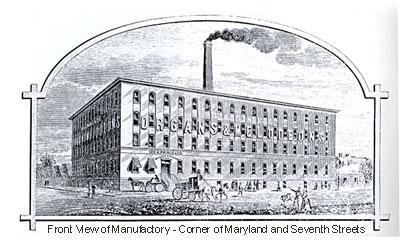 Unlike the piano, the melodeon seldom needed maintenance or tuning, and it was virtually indestructible in normal use. Its fame
spread through sales, news journals and trade periodical advertising, as well as in demonstrations both in the home and in wholesale depots,
dealer's stores and showrooms. A melodeon in the parlor provided ready musical entertainment, drawing family and friends together for song
and fellowship. Unlike the piano, the melodeon seldom needed maintenance or tuning, and it was virtually indestructible in normal use. Its fame
spread through sales, news journals and trade periodical advertising, as well as in demonstrations both in the home and in wholesale depots,
dealer's stores and showrooms. A melodeon in the parlor provided ready musical entertainment, drawing family and friends together for song
and fellowship.
Soon hundreds of thousands of Americans were acquiring melodeons - a phenomenon not unlike the spread of home television sets during the
1950s. By 1852, George A. Prince & Co. had wholesale depots in New York, Chicago, Cincinnati and Boston; also a growing network of agent -
dealers in St Louis, Philadelphia, Baltimore, Toronto and other major cities. The market expanded each year.
Prince, finding his Main Street to Pearl Street quarters no longer adequate, purchased on April 14, 1854 a one acre tract of land, the
northern portion of the West Side block bounded by Niagara, Maryland and Seventh streets, as a site for a new organ and melodeon "manufactory,"
to be second to none in the entire nation. The imposing new brick structure, erected in 1854?55, was designed by renowned Buffalo
builder-architect John Harley Selkirk (1808-1878). Selkirk was designer of the still-standing Illuminating Gas Company building at 249 West
Genesee St., as well as many other notable Buffalo homes, churches and office buildings.
In 1870, Selkirk built for his son George H., and himself a gray stone double house, in Greek revival style, at 205 and 207 Niagara St. In
December 1851, Prince had acquired nearby 208 Niagara St, a brick house, which became his residence.
Following Prince's business relocation to Maryland and Seventh streets in 1855, his firm's longtime storefront location at 200 Main St became
the home of T. & E. Dickinson Co., jewelry and clock merchants, founded in 1849. (Dickinson's became 254 Main St in 1868, the year the city
renumbered Main Street, all numbers advancing by about 50.)
A Place in Musical History
The Prince Co.'s importance as America's pioneer melodeon and reed organ manufacturer is recognized today.
American musical instrument historian Robert F Gellerman, in his 1973 volume The American Reed Organ, notes, "The George A. Prince Co. was the
leading manufacturer of reed organs in the United States from the 1850s until the 1870s, and many of the pioneers in the reed organ industry
worked for Prince in the early days."
Reed organ historian Horton Presley stated in a 1985 book Antique Reed Organs, "The fact remains that Carhart's efforts, and those of George
A. Prince, began the big swing to reed organs throughout America."
Also, renowned British musical instrument historian Arthur WJ.G. Ord-Hume, in his 1986 survey volume History of the Reed Organ and Its Makers,
observes: "(Jeremiah) Carhart's influence on the development of the reed organ in America cannot be overemphasized. No doubt much of this was due
to the fact that he was working with what was then America's leading reed organ or melodeon maker George A. Prince in Buffalo, New York. Carhart
gave his first reed organ the name `melodeon,' apparently the first to use this term."
In an 1873 feature article in the Buffalo Express, it was asserted that "The Manufactory of Messrs. Geo. A. Prince & Co. deservedly ranks
among the most important establishments in Buffalo, whether regard is had as to the magnitude of their operations or the finish and completeness
of the instruments manufactured."
Indeed, from its completion in 1855 the new Prince manufacturing establishment at Maryland and Seventh Streets became a source of civic pride
and local attention. Erected in the shape of an "L" with 270 feet of frontage on both streets, the imposing five-story brick structure,
containing 100,000 square feet of floor space, exemplified the most advanced industrial architecture of the day; described by the Buffalo Express
as “built expressly for the particular use for which it is occupied, is well lighted, ventilated, warmed by steam, and in its internal
arrangements is undoubtedly the model manufactory of its kind."
 The expanded firm numbered in excess of 200 mostly skilled workers (including some 75 to 100 of the best cabinetmakers in the
country). Prince's 1860 Illustrated Catalogue states "We are the pioneers and leading manufacturers of Melodeons in the world," a fact
confirmed by the Express, and that "24,000 Prince melodeons had been delivered to the public since the firm's 1846 founding." Competitor
Carhart & Needham & Co. of 97 East 23rd St, New York employed 80 workers in its peak years and had produced a total of 15,000
instruments when the firm closed in 1868. The expanded firm numbered in excess of 200 mostly skilled workers (including some 75 to 100 of the best cabinetmakers in the
country). Prince's 1860 Illustrated Catalogue states "We are the pioneers and leading manufacturers of Melodeons in the world," a fact
confirmed by the Express, and that "24,000 Prince melodeons had been delivered to the public since the firm's 1846 founding." Competitor
Carhart & Needham & Co. of 97 East 23rd St, New York employed 80 workers in its peak years and had produced a total of 15,000
instruments when the firm closed in 1868.
In its Illustrated Catalogue and in advertisements and promotional rhetoric, Messrs. Prince & Co. asserted that "its instruments' beauty
of appearance and exquisite quality of tone combined to make them popular throughout the face of the earth."
"Where in the wide, wide world is there a country or city to which a Prince melodeon or organ has not found its way? In every part and corner
of the civilized world they are to be found, speaking volumes for the enterprise and ingenuity of the manufacturers, gracing alike the mansion's
salon manufacturers, gracing alike the mansion's salon or the hovel's corner, their full, resonant chords accompanying the family voices about
the home altar, or pealing forth praises in the church or school room; in the far countries and near lands, the ship's cabin or foreign church
mission, wherever mankind have a local habitation."
The 1860 catalog shows, in addition to the popular five and six octaves, one and two key bank, piano style melodeons with four stops ($100 to
$200 range), a newly patented (1860) "New Organ Melodeon" with two keyboards and eight stops, weighing 400 pounds, with sufficient volume for
churches and public halls. It sold for $350.
The small, easy to play Prince portables, which by 1860 were known throughout the world, were a continually popular product line, (average
weight 70 pounds), ranging in price from $45 to $75. Carefully preserved examples of the early Prince portable reed organs (often called "singing
teacher's organs" as the hinged legs permitted them to be carried about easily) may be seen today in such world-class collections as the
Smithsonian Institution, Washington, D.C., all the way to the National Trust of Australia's Franklin House in Launceston, Tasmania. A Prince
"piano style" melodeon, built in a late Empire style with rosewood case and octagonal legs is in the 19thcentury musical instrument collection of
the Metropolitan Museum of Art in New York.
The lore and legends of America's flourishing 19th century reed organ and melodeon industry live on today in museums, public and private
collections, and a legion of reed organ enthusiasts. An outstanding historical collection of reed organs can be found in the rural village of
Deaneboro, N.Y., on Route 12B southwest of Utica. The Musical Museum there was established in 1948 by the Sanders family, which continues to
operate it
The museum is home to the Reed Organ Society, a national and international membership group. The society publishes a journal four times a
year. Leaders of the society include historians Robert F Gellerman, Horton Presley of Ottawa, Cynthia Hoover of the Musical Instruments History
staff of the National Museum of American History, Smithsonian Institution, and Barbara Owen of Newburyport, Mass., author of most of the reed
organ entries in the various New Grove Musical Instrument references.
The Musical Museum's earliest melodeon is a perfectly restored and operating small, one pedal Carhart model of 1849 date. Art Sanders
scratches his head quizzically about the two (Washington and Ottawa) Prince "petite" one-pedal melodeons of 1847-48, both of which he has
examined inside and out, and the identical 1849 Carhart in his collection. His practiced eye and half-century of reed organ experience tells him
it is more than resemblance.
Surely Carhart and Prince developed the pioneering design together and built the first prototype side by side in the same workshop. The rest
has become musical history.
Chase Viele has published many articles on historical subjects, at both the local and national levels. He is a
great-great-grandnephew of George A. Prince, founder of the Buffalo melodeon company that bears his name.
| 
 During the second half of the 19th century, Buffalo, New York could claim it was "The Melodeon Capital of the World." Today, few
people could describe a melodeon.
During the second half of the 19th century, Buffalo, New York could claim it was "The Melodeon Capital of the World." Today, few
people could describe a melodeon. The Buffalo City Directory for 1847-48 lists George A. Prince & Co., Music Store, and also "Geo. A. Prince & Co.,
Manufacturers of Carhart's Improved Melodeons," both at the same Main Street address. Carhart, holder of the patent, had sold manufacturing
rights to Prince while in his employ. Carhart and Needham, maintaining their own manufacturing rights, briefly operated a melodeon making
shop at 269 Main St, then departed for New York City where, in 1849, they established a melodeon "manufactory" at 77 East 13th St,
Manhattan.
The Buffalo City Directory for 1847-48 lists George A. Prince & Co., Music Store, and also "Geo. A. Prince & Co.,
Manufacturers of Carhart's Improved Melodeons," both at the same Main Street address. Carhart, holder of the patent, had sold manufacturing
rights to Prince while in his employ. Carhart and Needham, maintaining their own manufacturing rights, briefly operated a melodeon making
shop at 269 Main St, then departed for New York City where, in 1849, they established a melodeon "manufactory" at 77 East 13th St,
Manhattan. The Carhart-Prince collaboration is now American musical history. Prince's ambitious change from shopkeeper to proprietor of a
production manufactory foretold of an approaching new era in Buffalo's growth and commercial development. Depressed economic conditions had
followed the "land bust" of the late 1830s. Banks and mercantile firms failed due to inflated credit based on speculative land investments
and unstable currency. (Buffalo's first mayor, Dr. Ebenezer Johnson, was among scores of local investors who suffered bankruptcy.)
The Carhart-Prince collaboration is now American musical history. Prince's ambitious change from shopkeeper to proprietor of a
production manufactory foretold of an approaching new era in Buffalo's growth and commercial development. Depressed economic conditions had
followed the "land bust" of the late 1830s. Banks and mercantile firms failed due to inflated credit based on speculative land investments
and unstable currency. (Buffalo's first mayor, Dr. Ebenezer Johnson, was among scores of local investors who suffered bankruptcy.) Unlike the piano, the melodeon seldom needed maintenance or tuning, and it was virtually indestructible in normal use. Its fame
spread through sales, news journals and trade periodical advertising, as well as in demonstrations both in the home and in wholesale depots,
dealer's stores and showrooms. A melodeon in the parlor provided ready musical entertainment, drawing family and friends together for song
and fellowship.
Unlike the piano, the melodeon seldom needed maintenance or tuning, and it was virtually indestructible in normal use. Its fame
spread through sales, news journals and trade periodical advertising, as well as in demonstrations both in the home and in wholesale depots,
dealer's stores and showrooms. A melodeon in the parlor provided ready musical entertainment, drawing family and friends together for song
and fellowship. The expanded firm numbered in excess of 200 mostly skilled workers (including some 75 to 100 of the best cabinetmakers in the
country). Prince's 1860 Illustrated Catalogue states "We are the pioneers and leading manufacturers of Melodeons in the world," a fact
confirmed by the Express, and that "24,000 Prince melodeons had been delivered to the public since the firm's 1846 founding." Competitor
Carhart & Needham & Co. of 97 East 23rd St, New York employed 80 workers in its peak years and had produced a total of 15,000
instruments when the firm closed in 1868.
The expanded firm numbered in excess of 200 mostly skilled workers (including some 75 to 100 of the best cabinetmakers in the
country). Prince's 1860 Illustrated Catalogue states "We are the pioneers and leading manufacturers of Melodeons in the world," a fact
confirmed by the Express, and that "24,000 Prince melodeons had been delivered to the public since the firm's 1846 founding." Competitor
Carhart & Needham & Co. of 97 East 23rd St, New York employed 80 workers in its peak years and had produced a total of 15,000
instruments when the firm closed in 1868.
